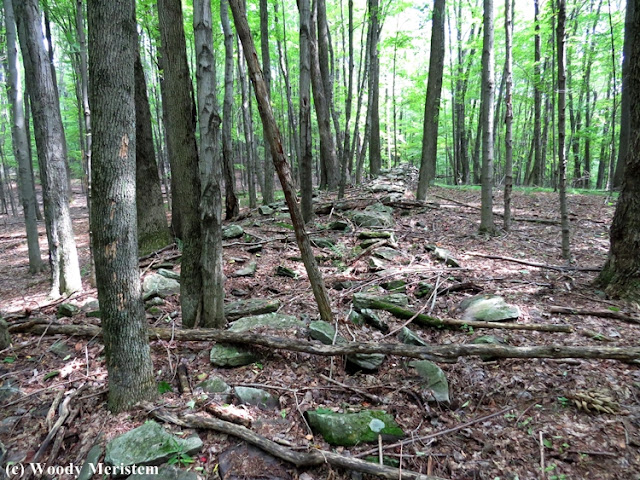Across northern Pennsylvania there are
areas that were settled in the mid-1800s by Irish immigrants, refugees from the
potato famine that ravaged Ireland in the late 1840s and early 1850s. Many of
those immigrants acquired land that had not yet been settled or cleared and
proceeded to establish small farms.
Last summer it was on one of those properties that I came upon a beautiful stone wall in the midst of woodland, built with skill and great effort. From the height and straight sides it appears this was a wall built to confine livestock, not just to dispose of stones picked from the fields or to mark a boundary line.
Last summer it was on one of those properties that I came upon a beautiful stone wall in the midst of woodland, built with skill and great effort. From the height and straight sides it appears this was a wall built to confine livestock, not just to dispose of stones picked from the fields or to mark a boundary line.
The current landowners know some of the history of
the property – it was cleared and the house was built by Irish immigrant Joseph
Farley in 1854. Joseph died at 88 in 1873; his grave is in the cemetery of the
Catholic church which lies two miles from the farm. Walking through the
cemetery it quickly becomes evident that all of the names on the older stones
are of Irish origin.
Apparently the farm’s prospects faded fairy
quickly and it was abandoned by 1936. It stood abandoned until the current owners bought it for a weekend getaway. The original house still stands,
although modified over the years, and must have looked like one that
still exists in more original form not far away –
The beautiful wall continues for quite a
way until it steps down to a section that was begun but never
completed.
There, adjacent to the low wall is a long
pile of stones – the raw material to complete the wall to its full
height. That pile enabled the builder to readily select just the right stone to put in place
next – or as one old wall builder told me years ago: in some places you need a
right-handed rock, in others a left-handed rock.
Further on the low wall gives way to a long
pile of stones that are in line with both the completed and uncompleted wall –
As so often happens in forest and field,
this incomplete wall has an aura of mystery. Who built the wall, when, and why
wasn’t it finished? The general consensus is that settlers could clear roughly
ten acres of woodland a year. Often this would be done by girdling and thus
killing the trees and then burning them in the next few years, after they had dried. As
the farmers planted crops, they would gather and pile interfering rocks until
they could be moved to the route of planned walls. On this property the rocks
were often mounded on large boulders until the rocks could be moved –
When Joseph Farley settled this land he was
in his late 60s and almost certainly would have needed help, probably from family or neighbors, in clearing the
land and building the wall. Barbed wire
became widely available in the 1870s; setting posts and stringing wire is much less labor intensive than building stone walls. Although there is no longer any evidence of barbed wire
along the route of the unfinished wall, it’s probable that Joseph’s successors
decided to use wire instead of finishing the wall.
And then the fields on either side of the
wall were abandoned and reverted to forest –
Well over a century after it was built, the
wall stands as a monument to the unending back-breaking toil of the early
settlers.







What a find! It's amazing how well that wall has stood the ravishments of time. It must have evoked some feelings of awe when you came across it. Thanks for informing us about the process of gathering the stones.
ReplyDeleteThat drystone wall is amazing, and so mysterious when you find it in the middle of the woods. I've heard of another here that I want to go and find next summer.
ReplyDeleteWhat a lovely area for hiking and visiting.
ReplyDeleteWow, this wall is amazing! I had to smile about a right-handed rock and a left-handed rock, but I think I understand.
ReplyDeleteWe don't get very much in the way of stone walls out here in western Canada, but I saw and admired some when I was in Scotland in 2016.
Kay
An Unfittie's Guide to Adventurous Travel
Wall is really well built. Mysterious too. Place is so amazing.
ReplyDeleteI am your new follower.love your interesting blog. hope you will also follow me back on G+.GFC and Bloglovin. please visit my blog.
https://clickbystyle.blogspot.in/